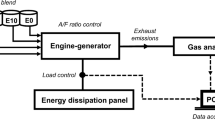Abstract
Due to the promotion of renewable energy sources, the demand for ethanol/automotive fuels has increased, whereby the ethanol is produced from biomass. As these fuels are flammable liquids, explosion protection concepts are needed for their transport, use and storage and for the operation of petrol stations. Safety characteristics are the basis of such concepts. Since the data for ethanol, on the one hand, and for automotive petrol, on the other hand, differ considerably, the relevant data for the ethanol/automotive petrol mixtures have to be determined and the existing explosion protection concepts will possibly have to be limited or modified.
For this reason the correlations between the necessary safety characteristics – flashpoint, boiling point, auto-ignition temperature, maximum experimental safe gap, upper explosion point – and the mixing ratio of ethanol and automotive fuel have been investigated. Based on the results of this investigations, those concentration limits are elaborated for which the existing safety concepts remain valid. For mixtures with an ethanol content going beyond such limits, suitable safety measures and requirements regarding explosion-protected equipment are derived. The changes that are necessary with respect to the safety concept of petrol stations when ethanol/automotive petrol mixtures are offered instead of or in addition to pure petrol are explained.
Zusammenfassung
Das Forcieren erneuerbarer Energiequellen führt zu einer steigenden Nachfrage nach ethanolhaltigen Ottokraftstoffen, wobei das Ethanol aus Biomasse hergestellt ist. Da auch die ethanolhaltigen Ottokraftstoffe zu den entzündbaren Flüssigkeiten zählen, sind Explosionsschutzkonzepte für Transport, Umgang, Lagern der Kraftstoffe und den Betrieb von Tankstellen notwendig. Sicherheitstechnische Kenngrößen sind die Basis solcher Sicherheitskonzepte. Da sich die entsprechenden Kenngrößen für Ethanol und Ottokraftstoff deutlich unterscheiden, müssen die relevanten sicherheitstechnischen Kenngrößen der Ethanol-Ottokraftstoff-Gemische bestimmt werden und die (für reinen Ottokraftstoff) existierenden Sicherheitskonzepte gegebenenfalls limitiert bzw. modifiziert werden.
Deshalb wurde die Abhängigkeit der notwendigen sicherheitstechnischen Kenngrößen – Flammpunkt, Siedepunkt, Zündtemperatur, flammendurchschlagsichere Spaltweite, oberer Explosionspunkt – von der Zusammensetzung der Ethanol-Ottokraftstoff-Gemische untersucht. Basierend auf den Ergebnissen dieser Untersuchungen wurde zum Einen der Ethanolanteil ermittelt, bis zu dem die existierenden Sicherheitskonzepte anwendbar sind. Zum Anderen wurden für Gemische mit höheren Ethanolanteilen geeignete Maßnahmen und Anforderungen an explosionsgeschütze Betriebsmittel abgeleitet. Die Änderungen bzw. zusätzlichen Maßnahmen im Vergleich zum Sicherheitskonzept der Tankstellen, die nur reinen Ottokraftstoff umschlagen, werden erläutert.
Similar content being viewed by others
References
EN 228:2004-03, Automotive fuels – Unleaded petrol – Requirements and test methods
CHEMSAFEData base for rated safety characteristics, edition 2004, edited by BAM, PTB, DECHEMA, http://www.dechema.de/Chemsafe.html
EN 12874:2001-04, Flame arresters – Performance requirements, test methods and limits for use
COUNCIL DIRECTIVE 67/548/EEC of 27 June 1967 on the approximation of laws, regulations and administrative provisions relating to the classification, packaging and labelling of dangerous substances
EUROPEAN PARLIAMENT AND COUNCIL DIRECTIVE 94/63/EC of 20 December 1994 on the control of volatile organic compound (VOC) emissions resulting from the storage of petrol and its distribution from terminals to service stations
TRbF 40, Tankstellen. BArbBl. 6/2002, p. 63
TRwS 781:2004, Technische Regel wassergefährdender Stoffe (TRwS), Tankstellen für Kraftstoffe. ATV-DVWK Deutsche Vereinigung für Wasserwirtschaft, Abwasser und Abfall e.V., Hennef
EN 858-2:2003, Separator systems for light liquids (e.g. oil and petrol) – Part 2: Selection of nominal size, installation, operation and maintenance
DIRECTIVE 94/9/EC OF THE EUROPEAN PARLIAMENT AND THE COUNCIL of 23 March 1994 on the approximation of the laws of the Member States concerning equipment and protective systems intended for use in potentially explosive atmospheres
DIRECTIVE 2008/68/EC OF THE EUROPEAN PARLIAMENT AND THE COUNCIL of 30 September 2008 on the Regulations for the Inland Transport of Dangerous Goods (ADR/RID/ADN)
COUNCIL DIRECTIVE 96/82/EC of 9 December 1996 on the control of major-accident hazards involving dangerous substances (Seveso II Directive)
LV47:2007, Anforderungen an Anlagen für bioethanolhaltige Kraftstoffe. Länderausschuss für Arbeitsschutz und Sicherheit (LASI) http://lasi.osha.de
TRwS 781-3:2008, Technische Regel wassergefährdender Stoffe (TRwS), Tankstellen für Kraftstoffe – Teil 3: Betankung von Kraftfahrzeugen mit Mischungen aus Ethanol und Ottokraftstoff. ATV-DVWK Deutsche Vereinigung für Wasserwirtschaft, Abwasser und Abfall e.V., Hennef
EN 13617-3:2004-11, Petrol filling stations – Part 3: Safety requirements for construction and performance of shear valves
EN ISO 3679:2004-07, Determination of flashpoint – Rapid equilibrium closed cup method
51794: 2003-05, Testing of mineral oil hydrocarbons – Determination of ignition temperature
pr EN 15794:2008, Determination of explosion points of flammable liquids
IEC 60079-4:1975-01, Electrical apparatus for explosive gas atmospheres. Part 4: Method of test for ignition temperature
EN 60079-0:2004-12, Electrical apparatus for explosive gas atmospheres – Part 0: General requirements
IEC 60079-1-1, 2002-07-05, Electrical apparatus for explosive gas atmospheres – Part 1-1: Flameproof enclosures ‘d’ – Method of test for ascertainment of maximum experimental safe gap
Brandes E, Frobese D-H, Mitu M (2006) Safety characteristics of ethanol/automotive fuel mixtures. OIL GAS Eur Mag 4:199–202
Brandes E, Frobese D-H, Mitu M (2007) Safety characteristics of ethanol/automotive fuel mixtures – Additional information. OIL GAS Eur Mag 9:124–125
EN 13016-1:2000-12, Liquid petroleum products – Vapour pressure – Determination of air saturated vapour pressure (ASVP)
Author information
Authors and Affiliations
Corresponding author
Rights and permissions
About this article
Cite this article
Brandes, E., Frobese, DH. Ethanol-containing automotive fuels – a safety concept for petrol stations in Germany . Forsch Ingenieurwes 73, 25–32 (2009). https://doi.org/10.1007/s10010-009-0092-5
Published:
Issue Date:
DOI: https://doi.org/10.1007/s10010-009-0092-5




